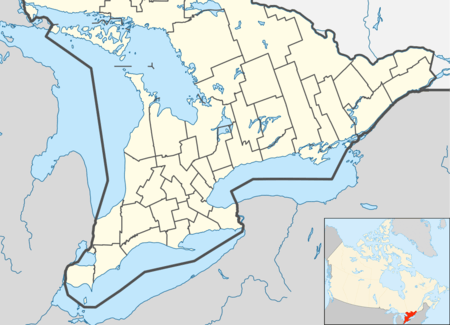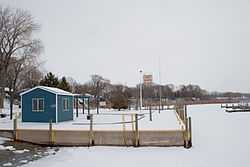Colchester, Ontario
| Colchester | |
|---|---|
|
Gas bar at Colchester harbour in winter | |
 Colchester Location in southern Ontario | |
| Coordinates: 41°59′11″N 82°56′05″W / 41.98639°N 82.93472°WCoordinates: 41°59′11″N 82°56′05″W / 41.98639°N 82.93472°W[1] | |
| Country | Canada |
| Province | Ontario |
| County | Essex |
| Town | Essex |
| Elevation[2] | 176 m (577 ft) |
| Time zone | Eastern Time Zone (UTC-5) |
| • Summer (DST) | Eastern Time Zone (UTC-4) |
| Postal code | N0R 1G0 |
| Area code(s) | 519, 226 |
Colchester is a community and unincorporated place in Southwestern Ontario,[1] the southernmost settlement on mainland Canada, and the southernmost point with the exception of Point Pelee National Park. It is located on the north shore of Lake Erie, approximately 6 kilometres south of the town of Harrow. Colchester was formerly part of the Township of Colchester South[3] and is now a part of the amalgamated Town of Essex within the County of Essex.[4][5] Colchester shares its postal code with Harrow as N0R 1G0.
Colchester is one of the first settled areas in Essex County. It was originally native land, but Europeans began to settle during the 18th century. Many United Empire Loyalists leaving the United States around the time of the American Revolutionary War were given land grants in Colchester. Some of names of these pioneers can still be found today in the names of residents throughout the region including: Snider, Huffman, Ferris, Hutchins, Iler, McCormick, Quick, and Tofflemire. One such Loyalist was John Snider of Pennsylvania. In 1798 Snider was given Lot 82 along the lakefront and built a home for his family just west of the village. As the oldest known structure along Lake Erie's shoreline, the house was completed in 1813 and a letter from the time indicates that men were working on the home's roof as cannons roared during the Battle of Lake Erie.[6]
The area was also a destination for slaves escaping the U.S. via the Underground Railroad in the mid-19th century, and for freed slaves during and after the American Civil War. In the 1870s a church was built along Dunn Road by many pioneering blacks, and it was named Zion African Methodist Episcopal (AME) Church. The church's cemetery still stands today on the western edge of the Road. Colchester was also the birthplace and hometown of railroad engineer and inventor Elijah McCoy, whose 45 patents and the invention of the locomotive lubrication cup led to the slogan "The real McCoy", denoting quality.[7]
Today, in addition to its many lakeside cottages, Colchester is home to several hundred year-round residents who have converted older homes and built new ones. Restaurants, a public beach, and a marina have been an important part of Colchester for some years now. The population is approximately 900.
Colchester lies along the southernmost road on mainland Canada, County Road 50, and has recently become a tourist destination because of the nearby wineries, the beach and harbour, and the scenery of the area. Every year, the village plays host to the "Colchester Villagefest" and "Explore the Shore", which are aimed at attracting visitors to the venues and attractions along the historic lakefront road. The village is also home to Christ Church Colchester (Anglican) which has a long history dating back to the beginnings of Colchester as a settlement.[8]
References
- ↑ 1.0 1.1 "Colchester". Geographical Names Data Base. Natural Resources Canada. Retrieved 2014-04-11.
- ↑ At geographic coordinates as taken from Google Earth on 11 April 2014
- ↑ "Townships of North and South Colchester" (JPG). Canadian County Atlas Project. McGill University. 2001. Retrieved 2014-04-11.
- ↑ Restructured municipalities - Ontario map #6 (Map). Restructuring Maps of Ontario. Ontario Ministry of Municipal Affairs and Housing. 2006. Retrieved 2014-04-11.
- ↑ Map 1 (PDF) (Map). 1 : 700,000. Official road map of Ontario. Ministry of Transportation of Ontario. 2010-01-01. Retrieved 2014-04-11.
- ↑ Pollock, Susan R. (29 October 2010). "Farmington couple's Ontario farmhouse has a long legacy". The Detroit News. Retrieved 2013-08-31.
- ↑ Drew, Benjamin (1856). The Refugee: On the Narratives of Fugitive Slaves in Canada Related by Themselves, with an Account of the History and Condition of the Colored Population of Upper Canada. Cleveland: John P. Jewett and Company.
- ↑ Harrow and Colchester South 1792-1992. Harrow Early Immigrant Research Society (Altona, Manitoba: Friesen Printers). 1993.
| Essex County, Ontario, Canada | |
|---|---|
| Transportation |
Current Provincial Highways: Highway 3 • Highway 77 • Highway 401 Former Provincial Highways: Highway 2 • Highway 39 • Highway 98 • Highway 107 • Highway 114 Essex County Roads: County Roads • Windsor Suburban Roads Railways: Essex Terminal Railway • Windsor Subdivision • Chatham Subdivision • CASO Subdivision |
| Municipalities | Amherstburg • Essex 1 • Kingsville • Lakeshore • LaSalle • Leamington • Pelee • Tecumseh • Windsor 2 |
| Communities | Belle River 3 • Colchester • Comber • Cottam • Deerbrook • Emeryville • Harrow 3 • Maidstone • Malden Centre • McGregor • Oldcastle • Puce • River Canard • Ruthven • St. Clair Beach3 • St. Joachim • Seacliffe • Stoney Point • Windsor • Woodslee |
| Attractions and Parks | Point Pelee National Park • Fort Malden National Historic Park • Jack Miner Bird Sanctuary • Colasanti's Tropical Gardens • ERCA • Chrysler Canada Greenway • Trans-Canada Trail |
| Geography | Bois Blanc Island • Detroit River • East Sister Island • Fighting Island • Middle Island • Peche Island • Pelee Island • Point Pelee |
| 1 County seat. 2 Separated Municipality, as of 1998. 3 Formerly a separate municipality, merged into another as of 1998. | |
| See also: List of municipalities in Ontario • Detroit, Michigan | |
